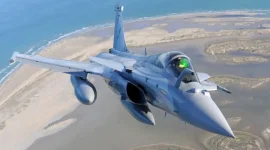- Views: 4K
- Replies: 34

Concerns have been raised over the Indian Navy's selection of the Rafale M fighter jet, with a serving naval official pointing out potential operational limitations similar to those experienced with the MiG-29K.
A key issue lies in the Rafale M's non-foldable wings, which pose challenges for storage and maneuverability on the relatively confined decks of India's aircraft carriers, INS Vikramaditya and INS Vikrant. This design constraint could limit the number of aircraft deployable on a carrier at any given time, impacting operational flexibility.
Furthermore, the Rafale M's twin-seater trainer variant is not carrier-compatible. This necessitates land-based training for pilots, hindering the development of crucial skills required for carrier take-offs and landings. While simulations and touch-and-go training can partially compensate, they cannot fully replicate the real-world conditions of carrier operations.
This contrasts with the MiG-29KUB, the twin-seater trainer variant of the MiG-29K, which is carrier-capable and provides a more realistic training environment. However, due to a series of crashes and subsequent scarcity, the Indian Navy's use of the MiG-29KUB has been limited, increasing reliance on simulators.
The official, who remained anonymous, suggested that the decision to procure the Rafale M was influenced by logistical and financial considerations, echoing the rationale behind the earlier MiG-29K acquisition. This raises concerns that operational efficiency may have been compromised in favor of commonality with the Indian Air Force's Rafale fleet and potential cost savings.
These limitations could impact the Indian Navy's operational readiness, particularly in terms of aircraft handling and pilot proficiency on carrier decks. The lack of a carrier-borne trainer aircraft may necessitate increased investment in simulation technologies or alternative training solutions to ensure pilots are adequately prepared for carrier operations.
While the Rafale M undoubtedly brings advanced combat capabilities to the Indian Navy, these concerns highlight the complexities of integrating foreign technology into the unique operational environment of aircraft carrier operations. The Navy may need to explore further modifications to the Rafale M or invest in enhanced training programs to mitigate these challenges and ensure optimal operational effectiveness.
The decision to acquire the Rafale M, despite its limitations, may have long-term implications for the Navy's carrier operations and future fleet composition.

